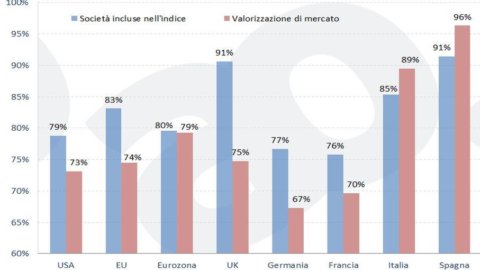I can't tell if invest in stocks has ever been “simple”, but certainly today it is less so. Until a year ago, in fact, prices were so low that any stock index offered interesting opportunities. This opportunity is simply not there anymore.
According to the Advise Only team, incurrent scenario, abundantly detailed in our "asset allocation", thestock investment is still convenient than that of bonds. But since the ratings are a fair value (prices are in line with the fundamentals), the future growth of share prices will inevitably be accompanied by earnings growth.
Up to now the forecasts of the strategist that I had in my hands are one-way and they see a growing stock market also for next year. According to the data collected by Bloomberg, all analysts estimate the earnings per share growing by8,8% in Europe and 4,7% in the USA. However, empirical evidence tells us that analysts tend to be too "generous" with forecasts and that these are usually revised downwards during the year.
With the two main stock lists (USA and Europe) now a fair value The earnings may be below expectations. As prices have moved higher, any deviations between actual and expected earnings are likely to have a greater impact on the benchmark than it did a year ago. We therefore have a greaterrisk associated with earnings disappointment.
This risk-disappointment, inspired by a Montier's book on the subject[1]can be expressed in two ways:
- number of companies that have i P / E expected for next year (2014) above the historical average;
- market valuation as a percentage of the benchmark index (ratio between the market capitalization of companies with P/E expected above the historical average and the capitalization of the benchmark index).
The basic idea is as follows: the greater the number of companies with expected P/E values lower than the historical market average and corresponding weighting on the reference index, the higher will be the risk that earnings below expectations will cause the entire stock index to collapse.
The graph tells us that in Europe and the USA, companies with P / E expected higher than the market average are many numerically and have a high incidence in terms of capitalization (respectively 73% and 74%). The risk associated with a profit disappointment it is therefore quite high and especially important inItaly (89%) e Spain (96%).
From a tactical point of view, if you are convinced that the next one will be the year of redemption and growth, there may still be some value within large-cap indices. In our view, the current valuations they are no longer particularly interesting and they are losing that margin of safety that we look for in an investment. Indeed, in theasset allocation of December we lowered the overall opinion of the European market eintroduced a sectoral theme to better seize market opportunities. Find out by accessing the free of charge document.
Up to now, our analysis has essentially focused on the reference indices (S & P500, FTSEMIB o Europe Stoxx) which group together the companies with the largest capitalisation, but the current conditions market (valuations and earnings risk) require us to broaden investment opportunities too outside these benchmarks. This will be the trajectory of ours asset allocation in 2014.





